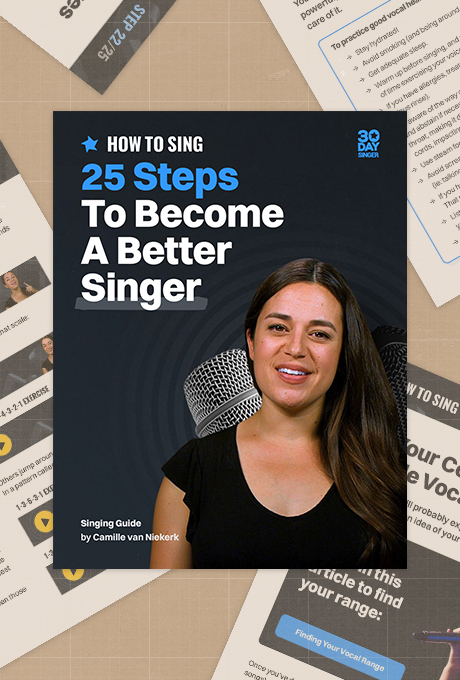Lip Trills - All About The Vocal Exercise
August 5, 2019Updated on July 11, 2024
By Camille Van Niekerk
Lip trills, what are they?
The lip trill is a fun and effective vocal exercise.
It's a great technique to use when learning how to sing.
Sometimes called “lip bubbles”, this exercise is essentially the noise you’d make if you were imitating the sound of a toy car or airplane.
The mouth is almost closed, lips buzzing or flapping together as you phonate (make noise) and release air.
Who uses lip trills?
Everyone!
Okay, maybe not everyone.
But they are widely used for good reason.
They’re great for anyone taking beginner vocal lessons.
They're also gentle enough for vocal rehab and they continue to be helpful for advanced singers growing their skills.
Celine Dion, Tori Kelly, and Nicole Scherzinger are just a few of the many professional singers who use lip trills in their practice.
How do you do it?
Because most of us made lip bubbles as kids during play, it’s sometimes easiest to find your lip trill by getting into that mindset.
Pretend like you’re playing with a toy race car, and you’re making the noise of the engine revving up.
Or pretend you’re a horse flapping its lips together.
Your mouth should be closed, lips relaxed as they buzz or roll together.
If you’ve got steady airflow for the lips to move and you’re phonating (making noise with your vocal folds) at the same time, then you’re doing it!
For more vocal warmup routines, check out the free singing lessons on 30 Day Singer.
What are they good for?
Lip trills are great for training efficient breath control and balanced tone.
Because they provide back pressure on the vocal folds, they’re also very helpful for vocal range extension.
I love the lip trill because it’s gentle, effective, and nearly impossible to hurt yourself with!
If you’re a singer who tends to strain or over-sing, lip trills can help you relax and use your voice most efficiently.
How do I use lip trills in my vocal practice?
Because they’re so gentle and relaxing, lip trills are a great way to begin and end your vocal warmup or practice session.
You can use a lip trill on any pattern, but I’d recommend starting with sirens and then increasing range, speed, and difficulty with some arpeggios or melisma/run patterns.
In your song work, you can practice by singing the melody on a lip trill to train healthy, balanced tone and breath control.
What if I can't do a lip trill?
Not everyone picks up the lip trill on day one.
It’s normal for it to take some time!
Here are a few tips if you haven’t gotten the hang of it yet:
-Support the cheeks and/or the corners of your mouth with your fingertips.
-Relax your lips and cheeks.
-Aim to just get the buzz going at first! Sustaining it will come later.
-Try a little bit every day. The more often you return to this coordination, the better.
-If it’s been weeks and you’re not making much progress, try an alternative exercise: sustained “V” sound, rolled “R”, or a raspberry (buzzing with the tongue sticking out).
Some Final Tips:
Especially in the beginning, you may be tempted to push air to keep the sound going.
Relax!
It really doesn’t take a lot of air.
Rather, it takes muscle coordination, which will come.
You also may be tempted to push when singing higher.
Instead, think about decreasing pressure and keeping your air flow consistent.
Don’t worry about maintaining one volume throughout your range.
Good luck, and happy singing!
FAQ
What is a lip trill?
A lip trill is a vocal exercise where you blow air through your lips, causing them to vibrate or "trill" together, often while singing a scale or melody.
How effective are lip trills?
Lip trills are super effective for warming up your voice, helping to ease tension, and improving breath control.
Do lip trills increase vocal range?
Yes, lip trills can help increase your vocal range by relaxing your vocal cords and making it easier to hit higher and lower notes.
Can anyone do lip trills?
Pretty much anyone can do lip trills, though it might take a bit of practice to get the hang of it if you're new to them.
What is the difference between a lip roll and a lip trill?
A lip roll is when you roll your lips like you're rolling an "r" sound, while a lip trill is more like a steady buzz or vibration of the lips.
Why do singers use lip trills to warm-up?
Singers use lip trills to warm up because they gently engage the vocal cords and help to relax the muscles, making it easier to sing without straining.
Why do singers move their jaw when they sing?
Singers move their jaw to help with articulation, control the sound, and to release tension, ensuring they can sing smoothly and clearly.
How often should you do lip trills?
You can do lip trills daily as part of your vocal warm-up routine to keep your voice in top shape.
How do you master lip trills?
Mastering lip trills involves practicing regularly, starting slow, and ensuring you're relaxed. Focus on a steady airflow and consistent lip vibration.
What is the difference between a lip trill and a shake?
A lip trill involves continuous, smooth vibration of the lips, while a shake typically refers to a deliberate, controlled oscillation in pitch or volume.


